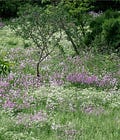Call Any Vegetable...
Seven years ago this week, Karen and I were driving across the Catskills We were en route to Ithaca (a town fondly described as “ten square miles surrounded by reality.”). It was hard not to notice that he sides of Route 30 were lined with thousands of flowers, in varying shades of white, pink, and lilac—Hesperis matronalis. “Ahhhhh,” I blurted, “A Wrec…


